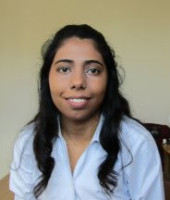Climate & Environment
Climate Change
Pollution
Terrestrial Biodiversity
Carbon Cycle
Greenhouse Gases Emissions
Air Quality
Agriculture, Crops & Soil Health
Post-Doctoral Fellowships
United Kingdom
2015.10.31
Plants Capture Carbon, but Will Ozone Get in the Way?
Plants are like humans, at least in the fact that ozone in the air around them is bad for their health. Ozone at ground level is an air pollutant that has negative effects on plant growth and physiological processes. What worries Dr. Divya Pandey is that the detrimental effects of ozone seem also to impact an important service provided by plants. They lock up carbon in their biomass and a part of it enters the soil instead of ending up in the atmosphere in the form of the climate-altering gas, carbon dioxide (a process called carbon sequestration). Not much data exists to understand the full extent of ozone’s effect on these carbon dynamics. With ozone concentrations projected to increase in important agricultural regions, like South and East Asia, Dr. Pandey is creating the tools needed to estimate the potential consequences for this natural carbon capture and sequestration, and the subsequent impact on climate change.
The carbon that a plant takes in from the air is distributed to different parts of its structure. When it drops its leaves or dies, part of the carbon is released, while part enters the soil as the plant decomposes. To get a clearer picture of these mechanisms, Dr. Pandey’s first step is to conduct experiments at a special facility in the UK allowing her to expose wheat plants to different levels of ozone and observe their growth. She will monitor changes to their roots, shoots and foliage, and to levels of soil carbon. She’ll also examine the processes that control carbon take-up by plants (like photosynthesis), in the soil (microbial action), and their interactions. These results will then allow Dr. Pandey to bring together two existing mathematical models: one that estimates the effect of ozone on plant growth and physiology, and another that uses details of plant growth to predict how much carbon will be stored in the soil, instead of escaping into the air.
Dr. Pandey’s new model will be among the first attempts to quantitatively connect the dots between atmospheric ozone and the consequences for carbon sequestration in soil. She will apply it to potential ozone scenarios for the UK to predict the future risks for soil carbon. This coupled model will also be adaptable to other regions and ecosystems. Understanding these processes in depth will help identify what steps need to be taken to preserve the carbon mitigation service provided by plants, or adapt to its reduction. The impact of ozone on agricultural crop loss is easier to quantify in terms of food production and economic implications and, thus, also in the gains to be had from air pollution controls. Dr. Pandey’s work is essential to do the same for soil carbon sequestration and to invest in the preservation of ecosystems providing natural carbon capture, as nature has always done.
Scientific title: What Level Of Risk Will Ground Level Ozone Pose To Soil Carbon Sequestration Over Coming Decades?
The carbon that a plant takes in from the air is distributed to different parts of its structure. When it drops its leaves or dies, part of the carbon is released, while part enters the soil as the plant decomposes. To get a clearer picture of these mechanisms, Dr. Pandey’s first step is to conduct experiments at a special facility in the UK allowing her to expose wheat plants to different levels of ozone and observe their growth. She will monitor changes to their roots, shoots and foliage, and to levels of soil carbon. She’ll also examine the processes that control carbon take-up by plants (like photosynthesis), in the soil (microbial action), and their interactions. These results will then allow Dr. Pandey to bring together two existing mathematical models: one that estimates the effect of ozone on plant growth and physiology, and another that uses details of plant growth to predict how much carbon will be stored in the soil, instead of escaping into the air.
Dr. Pandey’s new model will be among the first attempts to quantitatively connect the dots between atmospheric ozone and the consequences for carbon sequestration in soil. She will apply it to potential ozone scenarios for the UK to predict the future risks for soil carbon. This coupled model will also be adaptable to other regions and ecosystems. Understanding these processes in depth will help identify what steps need to be taken to preserve the carbon mitigation service provided by plants, or adapt to its reduction. The impact of ozone on agricultural crop loss is easier to quantify in terms of food production and economic implications and, thus, also in the gains to be had from air pollution controls. Dr. Pandey’s work is essential to do the same for soil carbon sequestration and to invest in the preservation of ecosystems providing natural carbon capture, as nature has always done.
Scientific title: What Level Of Risk Will Ground Level Ozone Pose To Soil Carbon Sequestration Over Coming Decades?
To add or modify information on this page, please contact us at the following address: community.research@axa.com

Divya
PANDEY
Institution
University of York
Country
United Kingdom
Nationality
Indian
Related articles
Climate & Environment
Climate Change
Finance, Investment & Risk Management
Societal Challenges
Climate Adaptation & Resilience
Insurance & Risk Management
Environmental Justice
Civil Society & Governance
AXA Project
Italy
AXA Research Lab on Climate Change, Risk and Justice
In response to three research questions: How can the private and financial sectors contribute to a just transition to a... Read more

Gianfranco
PELLEGRINO


